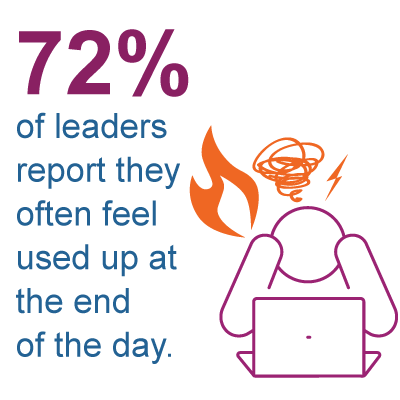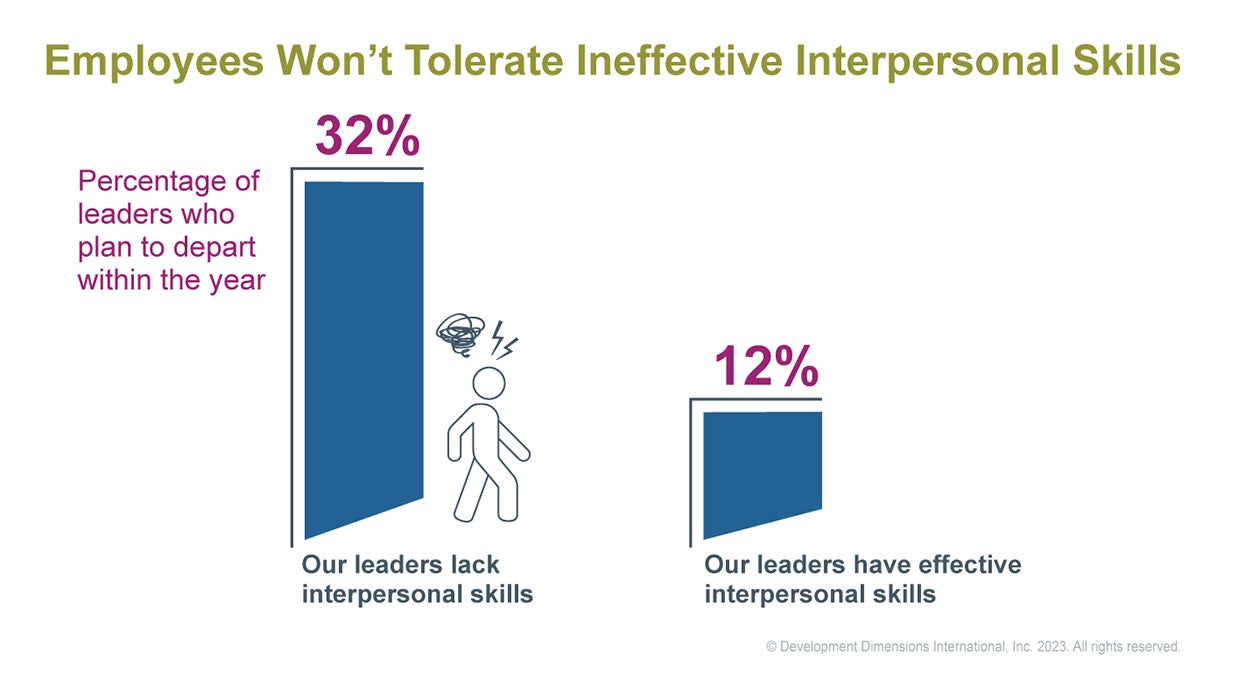
DDI’s most recent Global Leadership Forecast tells us that signs of burnout are growing among leaders, with 72% reporting that they often feel used up at the end of the day—an increase from 60% in 2020. Despite focusing more than ever on DE&I, physical safety, burnout, and retention, optimal outcomes continue to decline. As a result, employees are being pushed towards employers with leaders who can better support their workplace wellbeing.
In the past, wellness programs have largely relied on employees to put them into action, which is unlikely if they’re ending each workday feeling used up. That’s why leaders play such a critical role in ensuring that corporate wellness programs come to life and are actually used by employees.
Today’s workplace wellbeing initiatives should require leaders to shift from conventional, employee-driven wellness attempts that occur off the clock to fundamental changes that make wellbeing part of a larger work and organizational culture.
What is workplace wellbeing and why is it important?
Workplace wellbeing is a broad and increasingly important concept that revolves around building and maintaining a healthy work environment where employees can prosper. Implementing workplace wellness practices is critical because it helps build a positive, safe, and collaborative environment where employees can perform to the best of their abilities.
Teams that feel their organization cares about their wellbeing achieve higher customer engagement, profitability, productivity, and retention. Plus, they have fewer safety incidents. When an employee feels that they can bring their whole self to work, they feel valued.
It’s unrealistic for employees to compartmentalize the significant political, social, physical, and mental challenges that have defined the past several years–and they shouldn’t have to. When employee wellbeing is not prioritized holistically, it can impact an organization’s ability to retain talent. In fact, 81% of workers planned to look for workplaces that offered better support for their mental health.
We need to rethink what wellbeing looks like instead of defaulting to old workplace wellbeing practices. As noted in DDI’s Global Leadership Forecast 2023, “CEOs who are sounding the alarm about talent in their organizations need to evaluate their leadership culture. They need to think about how they set the tone and develop leaders who lead from a holistic, human-centered approach that incorporates the personal and practical needs of work.”
How do managers affect the wellbeing of their teams?
Almost 70% of people reported that their manager has greater impact on their mental health than their therapist or doctor. This just so happens to equal the impact of their partner. Managers set the tone for their teams, but too many of them put pressure on their teams to put work put over everything else. The best HR-created wellness program won’t be used if managers don’t afford teams the time and space to use it. Leaders must communicate that wellness is valuable in and of itself.
The key to success is engaging leaders to adopt a holistic and proactive approach.
To be holistic, leaders need to consider all the dimensions that impact a person’s quality of life. In addition to physical and mental health, wellbeing can include aspects such as social, intellectual, professional, environmental, or financial health. The dimensions of wellbeing are interconnected and affect the whole person as well as their behaviors.
Additionally, leaders need to create an environment that encourages their teams to take action proactively. As a leader, ask yourself these questions. Are your wellbeing efforts treating the symptoms or the causes? Is your team comfortable taking the steps they need to address their wellness as an ongoing habit, or only once they have reached a crisis? You want to set your employees up to do their best work, not just to recover from overwork. Proactive wellbeing actions aim to prevent negative impacts to employee wellness, such as burnout, stress, and low engagement.

Leaders should create engaging opportunities for their team that embody a sense of ownership and support as well as implement measures that emphasize employee wellness. One of the most powerful actions a leader can take is to model behaviors that promote wellbeing to their teams. In an “always on” workplace, it is challenging to avoid Zoom fatigue and constant multitasking. Not to mention the blurred lines that separate work time from personal time (and workspace from home space, if you don’t have a dedicated home office). When managers model clear boundaries for work-life balance, workers feel encouraged to prioritize their own sense of wellbeing.
Four Dimensions of Workplace Wellbeing
We have identified four key dimensions that leaders can focus on to improve overall employee wellbeing: physical wellbeing, mental wellbeing, social wellbeing, and career wellbeing.
Physical Wellbeing
“Can employees maintain a healthy and balanced life, without disease or infection?”
Physical wellness is usually at the center of corporate wellness programs. From “tobacco free” incentives to gym discounts to sick leave, these efforts are created to keep employees in good physical health so that they are able to stay productive and advance their careers.
While leaders do not need to offer advice or keep tabs on an employee’s health habits, they do have a responsibility to give their teams the time and space they need to care for their physical health. For example, whenever possible, they need to make it easy for employees to attend doctor appointments. When possible, leaders might offer flexibility to enable their teams to be physically active during the day. Leaders also have a responsibility to pay attention to workload, as overloaded workers struggle to get the rest they need, prepare healthful meals, or exercise.
Actions to Promote Physical Wellbeing:
- Encourage team members to take time off from work when they’re not feeling well.
- Give team members the time and space to care for their physical health.
- Consider "walking meetings" to encourage more movement during the workday.
Mental Wellbeing
“Do employees feel well and are they able to cope with daily life?”
Even before the pandemic, company leaders were beginning to incorporate mental health initiatives into their wellness programs. And this continues to be a key focus area. According to the U.S. Surgeon General’s 2022 report on workplace wellbeing, “84% of respondents said their workplace conditions had contributed to at least one mental health challenge.” Leaders have the ability to work with employees to help prioritize their workload and create a greater work-life balance. In addition, having leaders incorporate diversity and inclusion best practices in the workplace can have a major positive impact on the mental health of their employees.
Actions to Promote Mental Wellbeing:
- Set daily routines and help team members shift focus during meetings and tasks or decompress at the end of the workday. This could be something like blocking time for daily reflection or at the start of a meeting to stretch.
- Curb stigma against mental health. Be open about your own struggles and successes to build trust and psychological safety. Share information on company-provided mental health resources.
- Make room for flexible work hours and promote a work/life balance environment. Provide hybrid options, if possible.
- Provide training in skills such as resilience, emotional intelligence, and mindfulness to help employees manage stress.
Social Wellbeing
“Can employees create meaningful relationships with others and feel a sense of belonging?”
A recent Cigna study shows that nearly two-thirds of remote workers sometimes feel isolated or lonely, and 17% feel that way all the time. Further, remote workers are more likely to report feelings of unmeaningful relationships. With 58% of leaders now working in hybrid roles, it’s more challenging than ever for leaders to create meaningful connections with their teams. Leaders can’t just try to replicate in-person interactions in the virtual workplace–they need to imagine new ways of interacting and connecting in a virtual setting.
Actions to Promote Social Wellbeing:
- Demonstrate care and empathy in the workplace. This also means understanding team members’ roles outside the workplace (e.g., parent, child, grandparent, or caretaker).
- Create a safe space to help team members feel valued, heard, trusted, and have a sense of belonging. This can be achieved through regular one-on-one or team meetings, as long as employees feel psychologically safe to share different perspectives.
- Encourage team building activities to connect team members to one another and allow them to share ideas and concerns.
- Foster an inclusive environment for all team members. Prioritize diversity in the form of ideas and people and acknowledge any bias.
Career Wellbeing
“Do employees have the resources, motivation, and opportunities to achieve their goals?”
Employees want to work in places where they can feel purposeful and valued, use their strengths, and have opportunities to grow. In fact, 94% of people say that they would stay with a company that invests in their development needs, and there are steps leaders can take to create a work environment that motivates their teams.
Actions to Promote Career Wellbeing:
- Offer learning and development opportunities.
- Provide a balanced level of challenge to avoid disengagement and burnout.
- Celebrate milestones and accomplishments.
How do you know which dimension needs the most focus?
As a leader, it’s important to analyze which dimension requires more focus in your organization. Following the four steps listed below can help you determine your organization’s specific wellbeing needs.
- Pinpoint the dimensions missing from your current program.
- Enact specific strategies to address and enhance wellbeing in those areas.
- Model the behaviors yourself.
- Check in and follow up.
The Future of Workplace Wellbeing
Wellbeing will continue to be a critical conversation in the workplace moving forward. Employees will continue to choose working for employers who support their wellness. Successful managers in the future will work towards connecting wellbeing to their company values, culture, and everyday flow of work. Leaders have a profound responsibility to foster workplace wellbeing, and it all starts with the examples they set for their people.
Learn how to build leadership skills to support healthy, productive, and highly engaged teams with DDI’s leadership development subscription.
Lisa Rectenwald is a product manager at DDI, based in her hometown of Pittsburgh, PA. When she’s not creating new learning experiences for middle managers, Lisa can be found relaxing on the beach, staring at the stars, singing along to a Broadway musical, or traveling to a new city to see a Phish concert!
Topics covered in this blog

